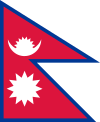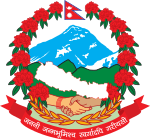Prime Minister of Nepal facts for kids
Quick facts for kids Prime Minister of the Federal Democratic Republic of Nepal |
|
|---|---|

|
|

Emblem of Nepal
|
|
| Style | The Right Honourable |
| Abbreviation | PM |
| Member of |
|
| Reports to |
|
| Residence | Kathmandu |
| Seat | Singha Durbar, Kathmandu |
| Appointer | President of Nepal |
| Term length | Five years |
| Constituting instrument | Article 76(2), Constitution of Nepal |
| Inaugural holder | Bhimsen Thapa |
| Formation | 1806 |
| Deputy | Deputy Prime Minister of Nepal |
The Prime Minister of Nepal (called Nēpālakō pradhānamantrī in Nepali) is the main leader of the government in the Federal Democratic Republic of Nepal. Think of them as the chief executive, like a school principal for the whole country! They lead a group of ministers called the Council of Ministers. This group helps run the country.
To stay in office, the Prime Minister needs the support of most members in the Pratinidhi Sabha, which is like Nepal's parliament. If they lose this support, they must step down.
The Prime Minister lives in an official home in Baluwatar, Kathmandu. Their main office is in a grand building called Singha Darbar. This building has been used for the Prime Minister's office for a very long time.
Currently, Sushila Karki, who was once the Chief Justice, has been serving as the interim Prime Minister since September 12, 2025. This happened after the previous Prime Minister, KP Sharma Oli, resigned on September 9, 2025, following public discussions.
Contents
Exploring the History of Nepal's Prime Ministers
The job of Prime Minister in Nepal has changed a lot over many years. It shows how Nepal's government and society have grown.
Early Days: Kings and Chiefs
At first, the Prime Minister's role was mostly symbolic. The real power belonged to the kings and powerful family leaders.
The Shah and Rana Eras
When the Shah monarchy began in the 1700s, the Prime Minister's job became more important. Strong nobles and royal advisors often held this title. They managed the government and the army.
Later, during the Rana period (from 1846 to 1951), the Prime Minister's position became hereditary. This meant it passed down within the Rana family. During this time, the Prime Minister had almost all the power. The king was mostly a ceremonial figure.
Modern Nepal: Democracy and Republic
The Rana rule ended in 1951. This started a new time of parliamentary democracy. Since then, the Prime Minister has been a key part of Nepal's government. The country went through different stages. These included kings with a constitution, many political parties, and times of change.
In 2008, Nepal became a federal democratic republic. This meant the monarchy ended. Now, the Prime Minister is the head of the government. They are in charge of making decisions and carrying out policies. The President of Nepal is the ceremonial head of state.
Understanding the Prime Minister's Powers
Nepal's Prime Minister has a very strong role, even more so than in some other countries with similar governments.
Leading the Government
The Constitution of Nepal clearly states that the main power to run the federal government belongs to the Council of Ministers. The Prime Minister is the leader of this Council. This means the Prime Minister and the Council together make important decisions and carry out government actions. In many other countries, the President might be the official head, but in Nepal, the Prime Minister truly leads the executive branch.
How Nepal's Prime Minister is Chosen
The Constitution of Nepal explains exactly how a Prime Minister is selected. It's a very important process!
The Election Process
First, after a national election, the President looks at the House of Representatives. The leader of the political party that wins the most seats (a majority) is usually chosen as Prime Minister.
Forming a Coalition Government
Sometimes, no single party wins a majority. In this case, different parties might team up to form a "coalition." The President then appoints a member of parliament (MP) who has the support of this group of parties. This person becomes the Prime Minister.
Confidence Vote
If a Prime Minister is appointed this way, they must prove they have the support of the House. They do this by winning a "confidence vote" within 30 days. If they don't win this vote, the process starts again to find someone who can lead the country with enough support. If no one can gain enough support within a certain time, new elections might be called.
When a Prime Minister Leaves Office
A Prime Minister's time in office can end in a few different ways, as explained in Nepal's Constitution.
Reasons for Leaving Office
- Resignation: The Prime Minister can choose to resign by writing to the President.
- Loss of Support: If the Prime Minister loses the support of the House of Representatives, they might lose a "vote of confidence." If this happens, they must leave office.
- No Longer an MP: If the Prime Minister stops being a member of the House of Representatives for any reason, they also leave their post.
- Death: Sadly, if a Prime Minister passes away, their term in office ends.
What Happens Next?
If a Prime Minister leaves office, the other ministers in the Council of Ministers usually continue their work. They do this until a new Prime Minister and Council are formed. If the Prime Minister dies, the most senior minister steps in as acting Prime Minister until a new one is appointed.
See also
 In Spanish: Primer ministro de Nepal para niños
In Spanish: Primer ministro de Nepal para niños


